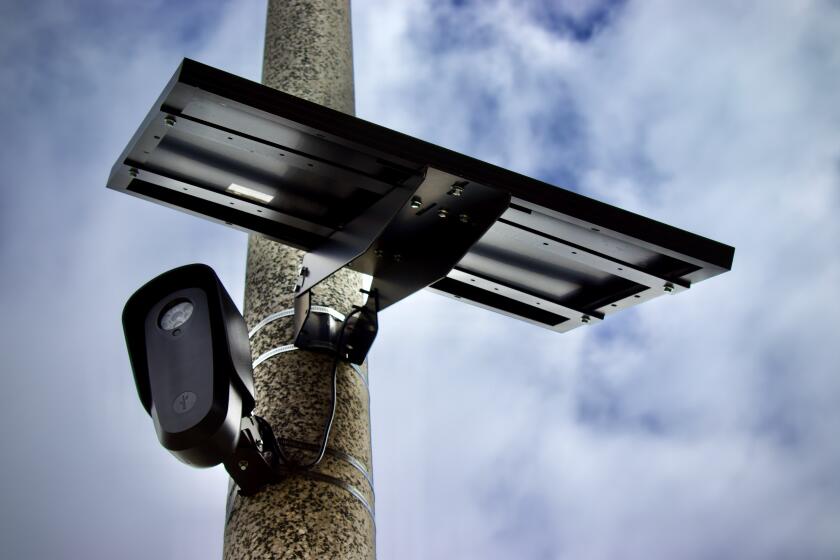Commentary: Time to retool San Diego’s skyline?
San Diego has an identity crisis.
On the one hand, real estate is booming. Sales continue to break records, and development races to keep up with demand. Over the past eight years, monthly housing construction starts have multiplied by six or seven times, making the area one of the “hottest markets” in the U.S. right now, according to Realtor.com.
On the other hand, new development generally is exacerbating a problem the region has had for decades — it is losing its unique character.
Apartment buildings and condos are going up all over downtown, but one after another is a generic vanilla midrise. Go to any other growing city in North America, and you see the same structures — architectural cookie cutters. These are the urban equivalent of the McMansion.
Even our best buildings aren’t much better. Among the most recognizable structures in the skyline, One America Plaza was designed by Chicago architect Helmut Jahn in the ’80s with a crown that resembles a screwdriver or drill bit — hence the skyline’s nickname, “The Toolbox.” Yet the same architect has peddled the same wares in several other major cities. Philadelphia has two, in fact. The U.S. Courthouse (2012) at Broadway and State Street is typical fare for New York architect Richard Meier. The Pacific Gate condo tower, now finishing at the west end of Broadway, is yet another prismatic glass tower from the global design firm KPF.
These are all decent designs, but they could be built quite literally anywhere. Where’s the “there” here?
San Diego has one of the world’s most distinctive settings: a perfect climate, gorgeous beaches, a welcoming bay, slender islands, rolling terrain, dramatics bluffs, mountains on the horizon, beautiful coastal vegetation. Our landscape has a singular sense of place, but our architecture wants to be somewhere else. Anywhere else, really.
It wasn’t always this way. Before the past half-century, generally everything built here was designed to fit well. Many older buildings, influenced by Spanish colonialism but specifically adapted to our materials and climate, are practically extruded from the land with earthen walls that keep them cool in the day and warm at night. The colors are bright enough to avoid absorbing too much heat but not so reflective to create discomforting glare (a serious problem with many modern glass buildings). Overhangs and ornament shade the walls and temper how much light bounces off, and deep recesses offer shady places to escape the sun. Towers and cupolas punctuate the skyline and often draw hot air up out of the buildings, making the spaces below more habitable.
While historic buildings such as the gorgeous Santa Fe Depot (1915) may no longer be feasible, architects need not copy the past to learn from its principles. Appropriate materials shaped around sun and wind not only are affordable — often they actually can save money by relying less on mechanical and electrical systems. Technically, few buildings need more than 30 percent glass to have good natural light and views without too much heat and energy consumption. Yet many new buildings are 100 percent glass. Optimal solar orientation requires facing most of a building’s exterior toward the north and south, to avoid undue heat gain when the sun drops low in the afternoon. San Diego’s roughly square urban grid demands ingenuity from architects to respect the city fabric while reaching intelligently and elegantly for the sky.
The benefits are clear. Research shows that distinctive architecture spurs home sales and occupancies, as well as stronger retail profits. Climate-responsive design can significantly reduce the energy consumption, operating costs and market value of buildings, as well as the comfort, health and well-being of occupants. And the aesthetic appeal of a place is among the most significant factors determining whether its residents are happy. Economists call this “the beauty premium.”
“Unique architecture” is routinely listed as one of the primary tourist attractions of cities such as New York, Chicago and Miami. “When people go on vacation,” says preservationist Richard Moe, “they generally seek out destinations that offer them the sense of being someplace, not just anyplace.” Think of Sante Fe, with its generous adobe. Or Nantucket, with its shingle siding weathered by the sea wind. Italian hill towns seem carved directly out of the hills. Now imagine San Diego with this kind of a consistent character, an architectural appeal that is unmistakably tailored to this place.
San Diego is a world-class city waiting to happen. Don’t we deserve a built environment more in sync with our natural environment? Let’s retool the toolbox.
Hosey, an architect and author, oversees design for the San Diego office of Harley Ellis Devereaux. His latest book is “The Shape of Green: Aesthetics, Ecology, and Design.”
Get Weekend Opinion on Sundays and Reader Opinion on Mondays
Editorials, commentary and more delivered Sunday morning, and Reader Reaction on Mondays.
You may occasionally receive promotional content from the San Diego Union-Tribune.





